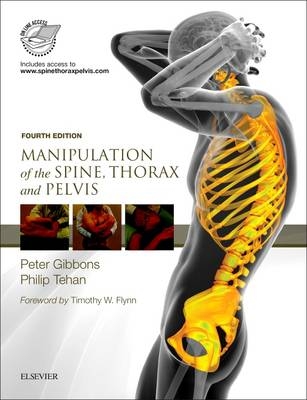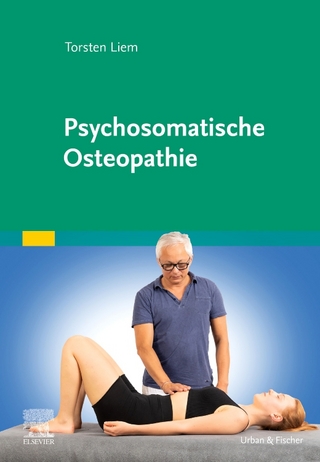
Manipulation of the Spine, Thorax and Pelvis
Elsevier Health Sciences (Verlag)
978-0-7020-5921-6 (ISBN)
The new edition addresses the important issues surrounding patient consent and discusses safety issues in the broader context of relative risk. New sections include appropriate use of manipulation when treating radiculopathy and musculoskeletal conditions in pregnant women and children. It also further encourages the practitioner to reflect on how they are performing manipulative techniques and thus focus on improving their skills.
Step-by-step coverage of 41 commonly used manipulation (HVLA) thrust techniques supported by 275 photographs/drawings and 56 videos
Concise technique summaries provide an innovative review process
A troubleshooting section in which difficulties with technique application can be addressed
Comprehensive review of spinal kinematics and spinal positioning for manipulation techniques
Examines evidence relating to cavitation and the clinical effectiveness of spinal manipulation
2-colour throughout with over 30 new images
Clinical history, presentation and examination for patients presenting with cervical artery dissection
Addresses the important issues surrounding patient consent
Additional research and guidelines that support the:
use of HVLA thrust techniques
use of spinal manipulation in the treatment of radiculopathy, pregnant women and children
Professor Peter GibbonsAdjunct Associate Professor Department of Rehabilitation SciencesCollege of Allied Health SciencesOklahoma University Health Science CenterUSA Professor Philip TehanAdjunct Associate Professor School of Biomedical and Health SciencesVictoria UniversityAustraliaAdjunct Associate Professor Department of Rehabilitation SciencesCollege of Allied Health SciencesOklahoma University Health Science CenterUSA
Foreword Preface Acknowledgements
Part A HVLA thrust techniques - an osteopathic perspective
1 Introduction 2 Osteopathic history, principles and practice 3 Kinematics and coupled motion of the spine 4 Minimal leverage positioning for HVLA thrust techniques 5 Safety and HVLA thrust techniques 6 Evidence informed practice 7 Consent
Part B HVLA thrust techniques
8 Cervical and cervicothoracic spine Note: Before reviewing up-slope and down-slope HVLA thrust techniques, the Introduction on the website should be viewed. 8.1 Atlanto-occipital joint C0-1: Contact point on occiput; Chin hold; Patient supine; Anterior and superior thrust in a curved plane; Ligamentous myofascial positioning 8.2 Atlanto-occipital joint C0-1: Contact point on atlas; Chin hold; Patient supine; Anterior and superior thrust in a curved plane; Ligamentous myofascial positioning 8.3 Atlanto-axial joint C1-2: Chin hold; Patient supine; Rotation thrust; Ligamentous myofascial positioning 8.4 Atlanto-axial joint C1-2: Cradle hold; Patient supine; Rotation thrust; Ligamentous myofascial positioning 8.5 Cervical spine C2-7: Up-slope gliding; Chin hold; Patient supine 8.6 Cervical spine C2-7: Up-slope gliding; Chin hold; Patient supine - variation 8.7 Cervical spine C2-7: Up-slope gliding; Cradle hold; Patient supine 8.8 Cervical spine C2-7: Up-slope gliding; Cradle hold; Patient supine; Reversed primary and secondary leverage 8.9 Cervical spine C2-7: Up-slope gliding; Patient sitting; Operator standing in front 8.10 Cervical spine C2-7: Up-slope gliding; Patient sitting; Operator standing to the side 8.11 Cervical spine C2-7: Down-slope gliding; Chin hold; Patient supine 8.12 Cervical spine C2-7: Down-slope gliding; Cradle hold; Patient supine 8.13 Cervical spine C2-7: Down-slope gliding; Patient sitting; Operator standing to the side 8.14 Cervicothoracic spine C7-T3: Rotation gliding; Patient prone; Operator at side of couch 8.15 Cervicothoracic spine C7-T3: Rotation gliding; Patient prone; Operator at head of couch 8.16 Cervicothoracic spine C7-T3: Rotation gliding; Patient prone; Operator at head of couch - variation 8.17 Cervicothoracic spine C7-T3: Sidebending gliding; Patient sitting 8.18 Cervicothoracic spine C7-T3: Sidebending gliding; Patient sitting; Ligamentous myofascial positioning 8.19 Cervicothoracic spine C7-T3: Sidebending gliding; Patient sidelying 8.20 Cervicothoracic spine C7-T3: Sidebending gliding; Patient sidelying; Ligamentous myofascial positioning 8.21 Cervicothoracic spine C7-T3: Extension gliding; Patient sitting; Ligamentous myofascial positioning
9 Thoracic spine and rib cage Note: Before reviewing thoracic spine and rib cage techniques the Upper limb positioning for sitting and supine thoracic spine techniques on the website should be viewed. 9.1 Thoracic spine T4-9: Extension gliding; Patient sitting; Ligamentous myofascial positioning 9.2 Thoracic spine T4-9: Flexion gliding; Patient supine; Ligamentous myofascial positioning 9.3 Thoracic spine T4-9: Rotation gliding; Patient supine; Ligamentous myofascial positioning 9.4 Thoracic spine T4-9: Rotation gliding; Patient prone; Short-lever technique 9.5 Ribs R1-3: Patient prone; Gliding thrust 9.6 Ribs R4-10: Patient supine; Gliding thrust; Ligamentous myofascial positioning 9.7 Ribs R4-10: Patient prone; Gliding thrust; Short-lever technique 9.8 Ribs R4-10: Patient sitting; Gliding thrust; Ligamentous myofascial positioning
10 Lumbar and thoracolumbar spine Note: Before reviewing sidelying HVLA thrust techniques in the lumbar and thoracolumbar spine, the Introduction on the website should be viewed. 10.1 Thoracolumbar spine T10-L2: Neutral positioning; Patient sidelying; Rotation gliding thrust 10.2 Thoracolumbar spine T10-L2: Flexion positioning; Patient sidelying; Rotation gliding thrust 10.3 Lumbar spine L1-5: Neutral positioning; Patient sidelying; Rotation gliding thrust 10.4 Lumbar spine L1-5: Flexion positioning; Patient sidelying; Rotation gliding thrust 10.5 Lumbar spine L1-5: Neutral positioning; Patient sitting; Rotation gliding thrust 10.6 Lumbosacral joint (L5-S1): Neutral positioning; Patient sidelying; Thrust direction is dependent on apophysial joint plane 10.7 Lumbosacral joint (L5-S1): Flexion positioning; Patient sidelying; Thrust direction is dependent on apophysial joint plane
11 Pelvis 11.1 Sacroiliac joint: Left innominate posterior; Patient prone; Ligamentous myofascial positioning 11.2 Sacroiliac joint: Right innominate posterior; Patient sidelying 11.3 Sacroiliac joint: Left innominate anterior; Patient supine 11.4 Sacroiliac joint: Sacral base anterior; Patient sidelying 11.5 Sacrococcygeal joint: Coccyx anterior; Patient sidelying
Part C Technique failure and analysis
Index
The website - www.spinethoraxpelvis.com - accompanying this text includes video sequences of all the techniques described in Part B (with the exception of the last technique described in Chapter 11.) These are indicated in the text by the following symbol. It also contains an image bank of downloadable images from the book. The website is designed to be used as an adjunct to the text and not as a stand-alone product.
| Erscheinungsdatum | 19.09.2016 |
|---|---|
| Verlagsort | London |
| Sprache | englisch |
| Maße | 191 x 235 mm |
| Gewicht | 840 g |
| Themenwelt | Medizin / Pharmazie ► Medizinische Fachgebiete ► Sportmedizin |
| Physiotherapie / Ergotherapie ► Behandlungstechniken ► Osteopathie | |
| ISBN-10 | 0-7020-5921-8 / 0702059218 |
| ISBN-13 | 978-0-7020-5921-6 / 9780702059216 |
| Zustand | Neuware |
| Haben Sie eine Frage zum Produkt? |
aus dem Bereich


